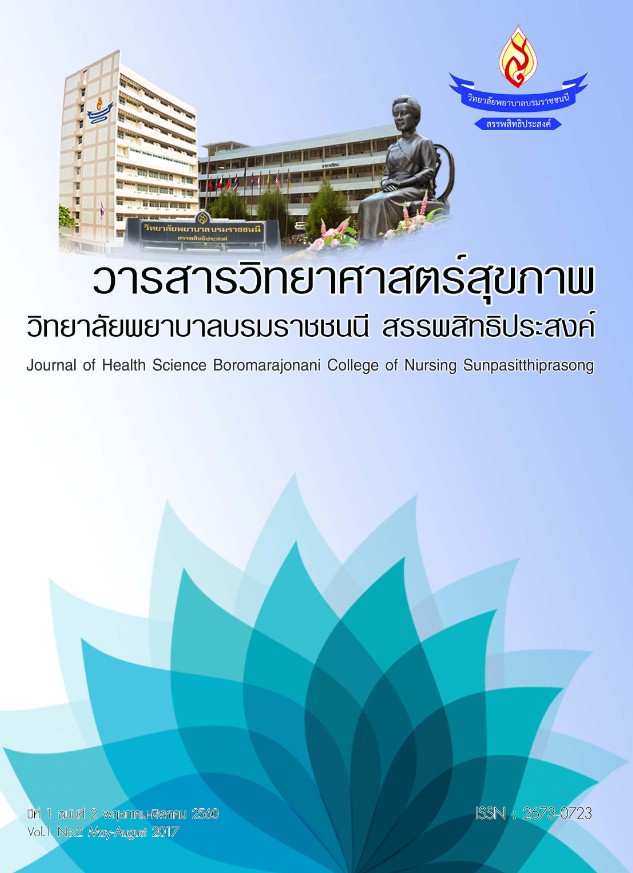การรับรู้เกี่ยวกับอุปสรรคการจัดการความปวดของพยาบาลวิชาชีพกลุ่มการพยาบาล โรงพยาบาลยโสธร จังหวัดยโสธร
คำสำคัญ:
การจัดการความปวด, อุปสรรคการจัดการความปวด, พยาบาลวิชาชีพบทคัดย่อ
อุปสรรคการจัดการความปวดของประเทศไทย อาจจะมีความแตกต่างตามบริบทพื้นที่และนโยบาย อีกทั้งยังมีข้อมูลจำกัดในประเด็นนี้ การวิจัยเชิงพรรณนาแบบภาคตัดขวางนี้มีวัตถุประสงค์เพื่อศึกษาการรับรู้ของพยาบาลเกี่ยวกับอุปสรรคการจัดการความปวด กลุ่มตัวอย่างเป็นพยาบาลวิชาชีพในโรงพยาบาลยโสธรจำนวน 218 คน เครื่องมือวิจัยเป็นแบบสอบถาม การรับรู้ที่เป็นอุปสรรคในการจัดการความปวด จำนวน 21 ข้อ มาตรวัด 5 ระดับ ผลการวิจัยพบว่าพยาบาลร้อยละ 100 เป็นเพศหญิง อายุเฉลี่ย 40.41 (SD±9.1) เป็นพยาบาลระดับปฏิบัติการเป็นส่วนใหญ่ ได้รับการอบรมการจัดการความปวดหลักสูตรระยะสั้น ร้อยละ 36.9 มีประสบการณ์ในการดูแลผู้ป่วยมากกว่า 10 ปี ร้อยละ 49.8 อุปสรรคการจัดการความปวด พบว่า พยาบาลเห็นความสำคัญของการจัดการความปวด รับรู้อุปสรรคการจัดการความปวดเกี่ยวกับ ความรู้ การประเมินความปวดในระดับปานกลาง และพยาบาลมีความกังวลต่อผู้ป่วยดื้อและติดยาบรรเทาความปวด แพทย์ให้การรักษาจัดการความปวดอยู่ในระดับมาก ความล่าช้าของเภสัชกรในการประมวลผล ใบสั่งยาของแพทย์ และความล่าช้าในการส่งยาจากแผนกจ่ายยาเป็นอุปสรรคอยู่ในระดับปานกลาง ผลการวิจัยที่พบเพื่อเป็นแนวทางการพัฒนาคุณภาพของพยาบาล ในการจัดการความปวดให้มีประสิทธิภาพ
เอกสารอ้างอิง
Wynne-Jones G, Main CJ. Overcoming pain as a barrier to work. Current opinion in supportive and palliative care 2011;5:131-6.
Potter VT, Wiseman CE, Dunn SM, Boyle FM. Patient barriers to optimal cancer pain control. Psycho‐Oncology 2003;12:153-60.
MacLean S, Obispo J, Young KD. The gap between pediatric emergency department procedural pain management treatments available and actual practice. Pediatric emergency care 2007;23:87-93.
Bair MJ, Matthias MS, Nyland KA, Huffman MA, Stubbs DL, Kroenke K, et al. Barriers and facilitators to chronic pain self‐management: A qualitative study of primary care patients with comorbid musculoskeletal pain and depression. Pain Medicine 2009;10:1280-90.
Chou R, Fanciullo GJ, Fine PG, Adler JA, Ballantyne JC, Davies P, et al. Clinical guidelines for the use of chronic opioid therapy in chronic noncancer pain. The Journal of Pain 2009;10:113-30. e22.
Dulko D, Hertz E, Julien J, Beck S, Mooney K. Implementation of cancer pain guidelines by acute care nurse practitioners using an audit and feedback strategy. Journal of the American Association of Nurse Practitioners 2010;22:45-55.
Deshpande MA, Holden RR, Gilron I. The impact of therapy on quality of life and mood in neuropathic pain: what is the effect of pain reduction? Anesthesia & Analgesia 2006;102:1473-9.
Parker SJ, Jessel S, Richardson JE, Reid MC. Older adults are mobile too! Identifying the barriers and facilitators to older adults’ use of mHealth for pain management. BMC geriatrics 2013;13:43.
Henry M. Knowledge and attitudes of nurses about pain management in patients with cancer. 2010.
Vincent CVH. Nurses’ knowledge, attitudes, and practices: Regarding children’s pain. MCN: The American Journal of Maternal/Child Nursing 2005;30:177-83.
Bernardi M, Catania G, Lambert A, Tridello G, Luzzani M. Knowledge and attitudes about cancer pain management: a national survey of Italian oncology nurses. European Journal of Oncology Nursing 2007;11:272-9.
Twycross A. Nurses' views about the barriers and facilitators to effective management of pediatric pain. Pain Management Nursing 2013;14:e164-e72.
Oldenmenger WH, Smitt PAS, van Dooren S, Stoter G, van der Rijt CC. A systematic review on barriers hindering adequate cancer pain management and interventions to reduce them: a critical appraisal. European Journal of Cancer 2009;45:1370-80.
Samuels JG, Fetzer S. Pain management documentation quality as a reflection of nurses' clinical judgment. Journal of nursing care quality 2009;24:223-31.
Bennett DS, Carr DB. Opiophobia as a barrier to the treatment of pain. Journal of pain & palliative care pharmacotherapy 2002;16:105-9.
Jacobsen R, Møldrup C, Christrup L, Sjøgren P. Patient‐related barriers to cancer pain management: a systematic exploratory review. Scand J Caring Sci 2009;23:190-208.
Luckett T, Davidson PM, Green A, Boyle F, Stubbs J, Lovell M. Assessment and management of adult cancer pain: a systematic review and synthesis of recent qualitative studies aimed at developing insights for managing barriers and optimizing facilitators within a comprehensive framework of patient care. J Pain Symptom Manage 2013;46:229-53.
Chen CH, Tang ST, Chen CH. Meta-analysis of cultural differences in Western and Asian patient-perceived barriers to managing cancer pain. Palliat Med 2012;26:206-21.
Lauzon Clabo LM. An ethnography of pain assessment and the role of social context on two postoperative units. Journal of advanced nursing 2008;61:531-9.
Czarnecki ML, Salamon KS, Thompson JJ, Hainsworth KR. Do barriers to pediatric pain management as perceived by nurses change over time?. Pain Manag Nurs 2014;15:292-305.
Wang HL, Tsai YF. Nurses’ knowledge and barriers regarding pain management in intensive care units. Journal of Clinical Nursing 2010;19: 3188-96.
Ameringer S. Barriers to pain management among adolescents with cancer. Pain Management Nurs 2010;11:224-33.
Czarnecki ML, Simon K, Thompson JJ, Armus CL, Hanson TC, Berg KA, et al. Barriers to pediatric pain management: A nursing perspective. Pain Management Nurs 2011;12:154-62.
ดาวน์โหลด
เผยแพร่แล้ว
รูปแบบการอ้างอิง
ฉบับ
ประเภทบทความ
สัญญาอนุญาต
บทความที่ได้รับการตีพิมพ์เป็นลิขสิทธิ์ของวารสารวิทยาศาสตร์สุขภาพ วิทยาลัยพยาบาลบรมราชชนนี สรรพสิทธิประสงค์ ข้อความที่ปรากฏในบทความแต่ละเรื่องเป็นความคิดเห็นส่วนตัวของผู้เขียนแต่ละท่านไม่เกี่ยวข้องกับวิทยาลัยพยาบาลบรมราชชนนี สรรพสิทธิประสงค์ และคณาจารย์ท่านอื่นๆ ในวิทยาลัยพยาบาลฯ ความรับผิดชอบเกี่ยวกับบทความแต่ละเรื่องผู้เขียนจะรับผิดชอบของตนเอง



